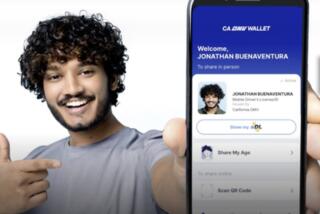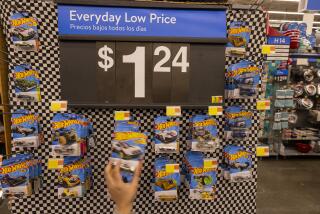Can Apple turn its iPhone and Watch into a wallet?
In any checkout line these days, many consumers are staring down at their smartphones.
With its new iPhone 6 and Apple Pay system, Apple Inc. hopes to get many of them to use the same phone like a credit card, promising easier and more secure transactions.
Previous efforts to replace plastic credit cards with digital transactions have met limited success, save for the use of text messages to donate to charities. Nearly half of Americans say they are uninterested in using their smartphones for credit card purchases, according to a survey by CreditCards.com, a division of Bankrate.com.
But breaches of security card data from retailers such as Home Depot and Target has heightened the appetite for new solutions, and Apple’s entrance into mobile pay could benefit from its powerful brand image and control over the hardware and software of its smartphones (and its new Apple Watch, also equipped for Apple Pay).
It’s “an opportunity to attract millions or hundreds of millions of people into mobile payments,” said Marc Massar, senior vice president for enterprise product and emerging solutions at Chase Paymentech, an arm of the banking behemoth, which is working closely with Apple Pay. “This is one of those watershed moments.”
Mobile payments aren’t new. Several companies have tried and failed over the last decade or two. The most celebrated attempt was Google’s “Wallet.”
The technology didn’t take off, Massar said, because attempts were limited to specific credit cards, or certain phones, or required pre-payment.
“This time it’s different,” he said.
Mastercard, Visa, American Express and other big names have signed on. So have a long list of major retailers, including Target and McDonald’s.
The ground was laid for Apple in 2009, when the federal government passed a law that made it much more difficult for credit card companies to require victims of fraud to pay for unauthorized purchases.
The momentum for more secure payments gained steam with major hacking attacks on Target and, more recently, Home Depot, among other major retailers.
Credit card companies, meanwhile, have been preparing new standards for so-called chip-and-PIN technology, now widespread across Europe. The cards store the sensitive information on a computer chip rather than a magnetic strip, which can be read by secret programs installed on card swipers.
Industry guidelines call for merchants to have chip-and-PIN technology in their stores by late 2015; hacked businesses would be responsible for fraud on any chip-embedded card if they don’t have an upgraded credit card terminal.
Apple now says it has an even more secure system that can be incorporated into those new machines before they’re installed.
Apple Pay uses a radio-wave technology to transmit the needed information for payment. No pin is required, just a press on the fingertip reader on the iPhone or Apple Watch. The credit card number doesn’t pass through the system, just a scrambled, one-time code that couldn’t be used in any future transaction.
Though Panera Bread and Whole Foods Market said Apple Pay was more about improving the customer experience than security, analysts said it’s clear the latter is a major factor for the excitement surrounding Apple Pay.
“When Target and Home Depot suffer large breaches, it changes the dynamic,” said Greg Martin, chief technology officer at the cybersecurity firm ThreatStream.
Fingerprints are not necessarily more secure than PINs, but they are certainly more convenient for customers, which is why security experts see Apple Pay being welcomed by consumers.
“To some extent, the fingerprint is just the sizzle, not the steak,” said John Bradley, senior technology architect at Ping Identity.
Some analysts say computer and mobile ordering could eventually prove more important than bricks-and-mortar purchases. Developers will be able to create online app stores — with Apple Pay taking the place of cumbersome form-filling for online purchases.
“What Apple did that is extremely smart is they brought in a total solution,” said Blaine Hurst, Panera Bread’s executive vice president of technology and transformation. “It wasn’t an app, it was a total solution for the consumer. They thought this through for everybody.”
Twitter: @peard33, @russ1mitchell
More to Read
Inside the business of entertainment
The Wide Shot brings you news, analysis and insights on everything from streaming wars to production — and what it all means for the future.
You may occasionally receive promotional content from the Los Angeles Times.












